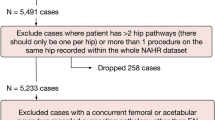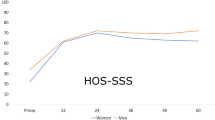Abstract
Purpose
The purpose of this study was to determine and establish the MCID for the NAHS at 2 years in patients undergoing hip arthroscopy for femoroacetabular impingement syndrome (FAIS).
Methods
Patients that underwent primary hip arthroscopy for FAIS between 2010 and 2016 were analyzed for eligibility. Data were collected from a single surgeon’s hip arthroscopy database. MCID was calculated for the NAHS utilizing a distribution-based method.
Results
The study included 298 patients (184 females) with an average age of 40.4 ± 13.0 years and average body mass index (BMI) of 25.7 ± 4.2 kg/m2. At baseline, the cohort’s average NAHS score was 48.7 ± 13.6 and demonstrated an improvement of 36.5 ± 17.0 for NAHS at follow-up. This resulted in MCID values of + 8.5 for NAHS.
Conclusion
This is the first study to report the MCID (+ 8.5) for NAHS following primary hip arthroscopy, and as such, is a valuable contribution to future hip arthroscopy research.
Level of evidence
IV.
Similar content being viewed by others
Change history
03 February 2022
A Correction to this paper has been published: https://doi.org/10.1007/s00167-021-06858-4
References
Akpinar B, Lin LJ, Bloom DA, Youm T (2021) Hip arthroscopy for femoroacetabular impingement: 1-year outcomes predict 5-year outcomes. Am J Sports Med 49:104–111
Bloom DA, Kirby DJ, Thompson K, Baron SL, Chee C, Youm T (2020) Effect of acetaminophen on postoperative percocet use in hip arthroscopy: a randomized controlled trial. Arthroscopy 37(2):530–536. https://doi.org/10.1016/j.arthro.2020.09.046
Brick CR, Bacon CJ, Brick MJ (2020) Importance of retaining sufficient acetabular depth: successful 2-year outcomes of hip arthroscopy for patients with pincer morphology as compared with matched controls. Am J Sports Med 48:2471–2480
Brinkman JC, Domb BG, Krych AJ, Levy BA, Makovicka JL, Neville M et al (2020) Is labral size predictive of failure with repair in hip arthroscopy? Arthroscopy 36:2147–2157
Bryan AJ, Krych AJ, Pareek A, Reardon PJ, Berardelli R, Levy BA (2016) Are short-term outcomes of hip arthroscopy in patients 55 years and older inferior to those in younger patients? Am J Sports Med 44:2526–2530
Chahal J, Van Thiel GS, Mather RC, Lee S, Song SH, Davis AM et al (2015) The patient acceptable symptomatic state for the modified harris hip score and hip outcome score among patients undergoing surgical treatment for femoroacetabular impingement. Am J Sports Med 43:1844–1849
Chandrasekaran S, Darwish N, Gui C, Lodhia P, Suarez-Ahedo C, Domb BG (2016) Outcomes of hip arthroscopy in patients with tönnis grade-2 osteoarthritis at a mean 2-year follow-up: evaluation using a matched-pair analysis with tönnis grade-0 and grade-1 cohorts. J Bone Jt Surg Am 98:973–982
Chandrasekaran S, Gui C, Darwish N, Lodhia P, Suarez-Ahedo C, Domb BG (2016) Outcomes of hip arthroscopic surgery in patients with Tönnis grade 1 osteoarthritis with a minimum 2-year follow-up: evaluation using a matched-pair analysis with a control group with Tönnis grade 0. Am J Sports Med 44:1781–1788
Christensen CP, Althausen PL, Mittleman MA, Lee J-a, McCarthy JC (2003) The nonarthritic hip score: reliable and validated. Clin Orthop Relat Res 406:75–83
Cook CE (2008) Clinimetrics corner: the Minimal clinically important change score (MCID): a necessary pretense. J Man Manip Ther 16:82E-83E
Copay AG, Eyberg B, Chung AS, Zurcher KS, Chutkan N, Spangehl MJ (2018) Minimum clinically important difference. JBJS Rev 6:e2
Copay AG, Subach BR, Glassman SD, Polly DW Jr, Schuler TC (2007) Understanding the minimum clinically important difference: a review of concepts and methods. Spine J 7:541–546
Cvetanovich GL, Weber AE, Kuhns BD, Alter J, Harris JD, Mather RC 3rd et al (2018) Hip arthroscopic surgery for femoroacetabular impingement with capsular management: factors associated with achieving clinically significant outcomes. Am J Sports Med 46:288–296
Domb BG, Battaglia MR, Perets I, Lall AC, Chen AW, Ortiz-Declet V et al (2019) Minimum 5-year outcomes of arthroscopic hip labral reconstruction with nested matched-pair benchmarking against a labral repair control group. Am J Sports Med 47:2045–2055
Domb BG, Chaharbakhshi EO, Perets I, Walsh JP, Yuen LC, Ashberg LJ (2018) Patient-reported outcomes of capsular repair versus capsulotomy in patients undergoing hip arthroscopy: minimum 5-year follow-up—a matched comparison study. Arthroscopy 34:853–863
Domb BG, Martin TJ, Gui C, Chandrasekaran S, Suarez-Ahedo C, Lodhia P (2018) Predictors of clinical outcomes after hip arthroscopy: a prospective analysis of 1038 patients with 2-year follow-up. Am J Sports Med 46:1324–1330
Essilfie AA, Bloom DA, Zusmanovich M, Kester B, Wolfson T, Youm T (2020) Staged bilateral hip arthroscopy compared with a matched unilateral hip arthroscopy group: minimum 2-year follow-up. Arthroscopy 36(7):1856–1861. https://doi.org/10.1016/j.arthro.2020.02.025
Griffin DR, Dickenson EJ, O’Donnell J, Agricola R, Awan T, Beck M et al (2016) The warwick agreement on femoroacetabular impingement syndrome (FAI syndrome): an international consensus statement. Br J Sports Med 50:1169–1176
Griffin DR, Dickenson EJ, Wall PDH, Achana F, Donovan JL, Griffin J et al (2018) Hip arthroscopy versus best conservative care for the treatment of femoroacetabular impingement syndrome (UK FASHIoN): a multicentre randomised controlled trial. Lancet 391:2225–2235
Hamula MJ, Ryan MK, Baron SL, Bloom DA, Youm T (2019) Atypical hip pain in femoroacetabular impingement: a comparison of outcomes based on primary hip pain location. Am J Sports Med 48(1):167–172
Harris WH (1969) Traumatic arthritis of the hip after dislocation and acetabular fractures: treatment by mold arthroplasty. An end-result study using a new method of result evaluation. J Bone Jt Surg Am 51:737–755
Hassebrock JD, Krych AJ, Domb BG, Levy BA, Neville MR, Hartigan DE (2019) Bilateral hip arthroscopy: can results from initial arthroscopy for femoroacetabular impingement predict future contralateral results? Arthroscopy 35:1837–1844
Jacobs CA, Peabody MR, Duncan ST, Muchow RD, Nunley RM, Group A et al (2018) Development of the HOOSglobal to assess patient-reported outcomes in patients undergoing hip preservation procedures. Am J Sports Med 46:940–946
Kaplan DJ, Samim M, Burke CJ, Baron SL, Meislin RJ, Youm T (2020) Decreased hip labral width measured via preoperative MRI is associated with inferior outcomes for arthroscopic labral repair for femoroacetabular impingement. Arthroscopy 37(1):98–107
Kemp JL, Collins NJ, Roos EM, Crossley KM (2013) Psychometric properties of patient-reported outcome measures for hip arthroscopic surgery. Am J Sports Med 41:2065–2073
Kivlan BR, Martin RL, Christoforetti JJ, Wolff AB, Nho SJ, Salvo JP Jr et al (2019) The patient acceptable symptomatic state of the 12-item international hip outcome tool at 1-year follow-up of hip-preservation surgery. Arthroscopy 35:1457–1462
Kuhns BD, Hannon CP, Makhni EC, Alter J, Mather RC 3rd, Salata MJ et al (2017) A comparison of clinical outcomes after unilateral or bilateral hip arthroscopic surgery: age- and sex-matched cohort study. Am J Sports Med 45:3044–3051
Larson CM, Ross JR, Stone RM, Samuelson KM, Schelling EF, Giveans MR et al (2016) Arthroscopic management of dysplastic hip deformities: predictors of success and failures with comparison to an arthroscopic FAI cohort. Am J Sports Med 44:447–453
Lee S, Frank RM, Harris J, Song SH, Bush-Joseph CA, Salata MJ et al (2015) Evaluation of sexual function before and after hip arthroscopic surgery for symptomatic femoroacetabular impingement. Am J Sports Med 43:1850–1856
Levy DM, Kuhns BD, Chahal J, Philippon MJ, Kelly BT, Nho SJ (2016) Hip Arthroscopy outcomes with respect to patient acceptable symptomatic state and minimal clinically important difference. Arthroscopy 32:1877–1886
Litrenta JM, Mu BH, Chen AW, Perets I, Ortiz-Declet V, Domb BG (2019) Arthroscopic labral treatment in adolescents: clinical outcomes with minimum 5-year follow-up. Am J Sports Med 47:870–875
Martin RL, Kelly BT, Philippon MJ (2006) Evidence of validity for the hip outcome score. Arthroscopy 22:1304–1311
Martin RL, Philippon MJ (2007) Evidence of validity for the hip outcome score in hip arthroscopy. Arthroscopy 23:822–826
Nakashima H, Tsukamoto M, Ohnishi Y, Utsunomiya H, Kanezaki S, Sakai A et al (2019) Clinical and radiographic predictors for unsalvageable labral tear at the time of initial hip arthroscopic management for femoroacetabular impingement. Am J Sports Med 47:2029–2037
Norman GR, Sloan JA, Wyrwich KW (2003) Interpretation of changes in health-related quality of life: the remarkable universality of half a standard deviation. Med Care 41:582–592
Nwachukwu BU, Beck EC, Kunze KN, Chahla J, Rasio J, Nho SJ (2020) Defining the clinically meaningful outcomes for arthroscopic treatment of femoroacetabular impingement syndrome at minimum 5-year follow-up. Am J Sports Med 48:901–907
Nwachukwu BU, Beck EC, Lee EK, Cancienne JM, Waterman BR, Paul K et al (2020) Application of machine learning for predicting clinically meaningful outcome after arthroscopic femoroacetabular impingement surgery. Am J Sports Med 48:415–423
Nwachukwu BU, Chang B, Beck EC, Neal WH, Movassaghi K, Ranawat AS et al (2019) How should we define clinically significant outcome improvement on the iHOT-12? HSS J 15:103–108
Nwachukwu BU, Chang B, Rotter BZ, Kelly BT, Ranawat AS, Nawabi DH (2018) Minimal clinically important difference and substantial clinical benefit after revision hip arthroscopy. Arthroscopy 34:1862–1868
Pennock AT, Bomar JD, Johnson KP, Randich K, Upasani VV (2018) Nonoperative management of femoroacetabular impingement: a prospective study. Am J Sports Med 46:3415–3422
Perets I, Chaharbakhshi EO, Mu B, Ashberg L, Battaglia MR, Yuen LC et al (2018) Hip arthroscopy in patients ages 50 years or older: minimum 5-year outcomes, survivorship, and risk factors for conversion to total hip replacement. Arthroscopy 34:3001–3009
Perets I, Craig MJ, Mu BH, Maldonado DR, Litrenta JM, Domb BG (2018) Midterm outcomes and return to sports among athletes undergoing hip arthroscopy. Am J Sports Med 46:1661–1667
Perets I, Rybalko D, Chaharbakhshi EO, Mu BH, Chen AW, Domb BG (2018) Minimum five-year outcomes of hip arthroscopy for the treatment of femoroacetabular impingement and labral tears in patients with obesity: a match-controlled study. J Bone Jt Surg Am 100:965–973
Ramisetty N, Kwon Y, Mohtadi N (2015) Patient-reported outcome measures for hip preservation surgery-a systematic review of the literature. J Hip Preserv Surg 2:15–27
Reider B (2015) Good, or just better? Am J Sports Med 43(8):1841–1843
Rosinsky PJ, Kyin C, Lall AC, Shapira J, Maldonado DR, Domb BG (2019) Rate of return to sport and functional outcomes after bilateral hip arthroscopy in high-level athletes. Am J Sports Med 47:3444–3454
Saito M, Utsunomiya H, Hatakeyama A, Nakashima H, Nishimura H, Matsuda DK et al (2019) Hip arthroscopic management can improve osteitis pubis and bone marrow edema in competitive soccer players with femoroacetabular impingement. Am J Sports Med 47:408–419
Stone AV, Jacobs CA, Luo TD, Meadows MC, Nho SJ, Stubbs AJ et al (2018) High degree of variability in reporting of clinical and patient-reported outcomes after hip arthroscopy. Am J Sports Med 46:3040–3046
Funding
There are no funding conflicts associated with this project for any of the authors.
Author information
Authors and Affiliations
Corresponding author
Ethics declarations
Conflict of interest
There are no conflict of interests for any of the authors listed with this research project.
Ethics approval
There are no ethical conflicts associated with this project for any of the authors.
Additional information
Publisher's Note
Springer Nature remains neutral with regard to jurisdictional claims in published maps and institutional affiliations.
I certify this manuscript is original and is not under consideration for publication elsewhere.
The original online version of this article was revised: Duplicated text in Article Copyright Holdername corrected.
Rights and permissions
About this article
Cite this article
Bloom, D.A., Kaplan, D.J., Kirby, D.J. et al. The minimal clinically important difference for the nonarthritic hip score at 2-years following hip arthroscopy. Knee Surg Sports Traumatol Arthrosc 30, 2419–2423 (2022). https://doi.org/10.1007/s00167-021-06756-9
Received:
Accepted:
Published:
Issue Date:
DOI: https://doi.org/10.1007/s00167-021-06756-9




